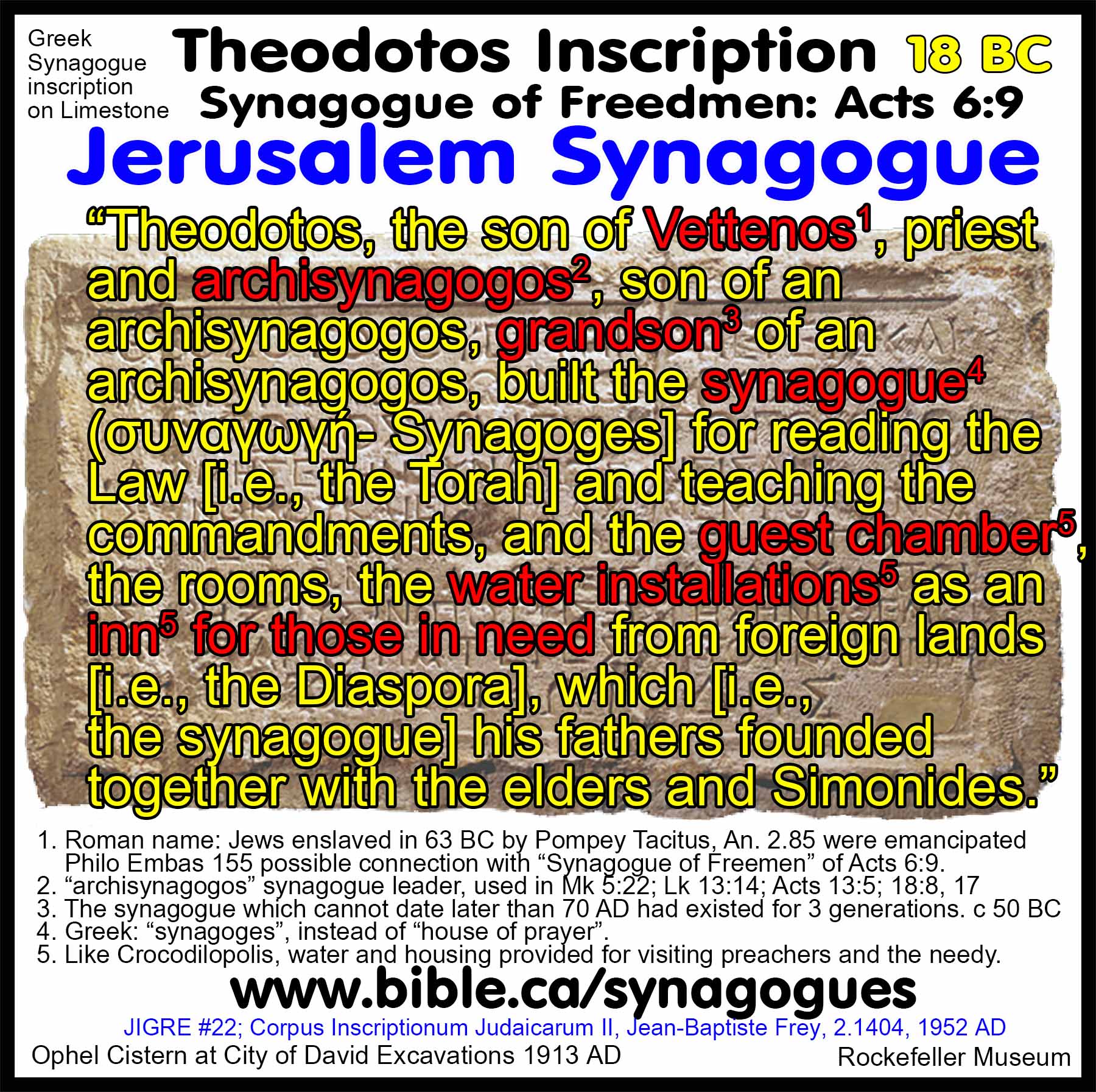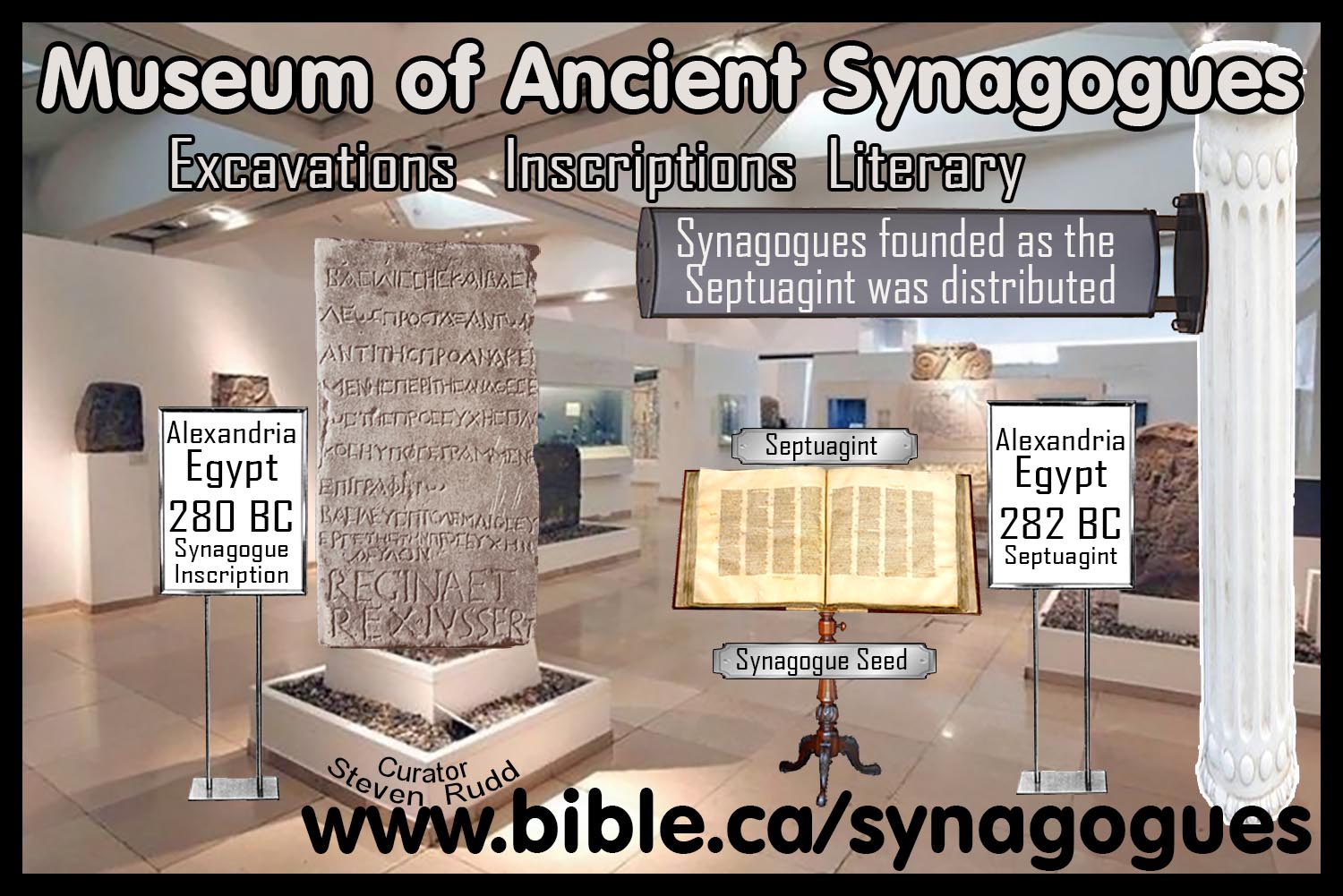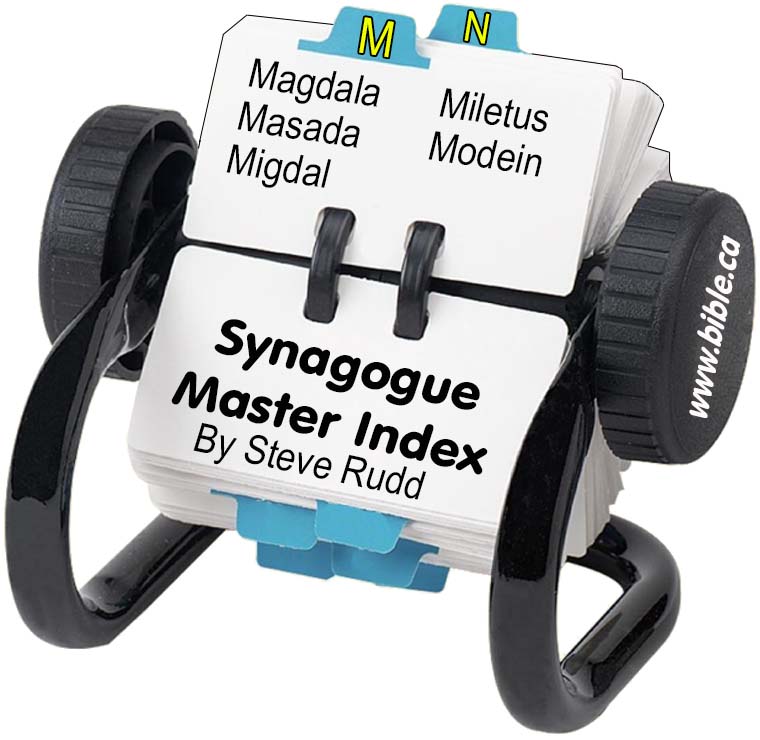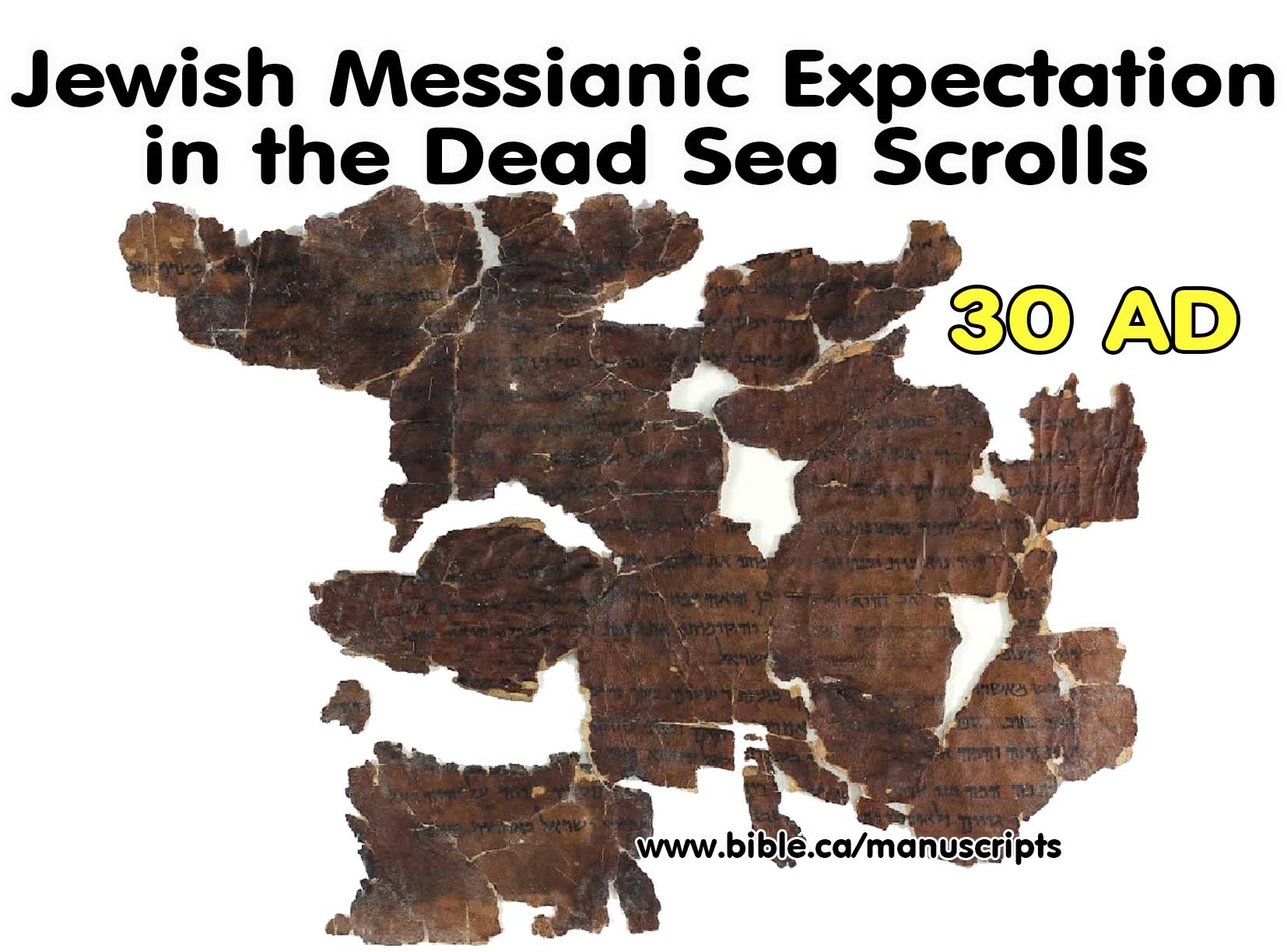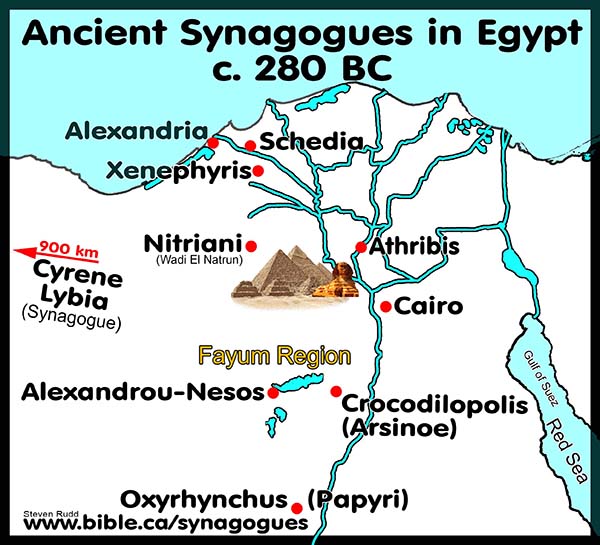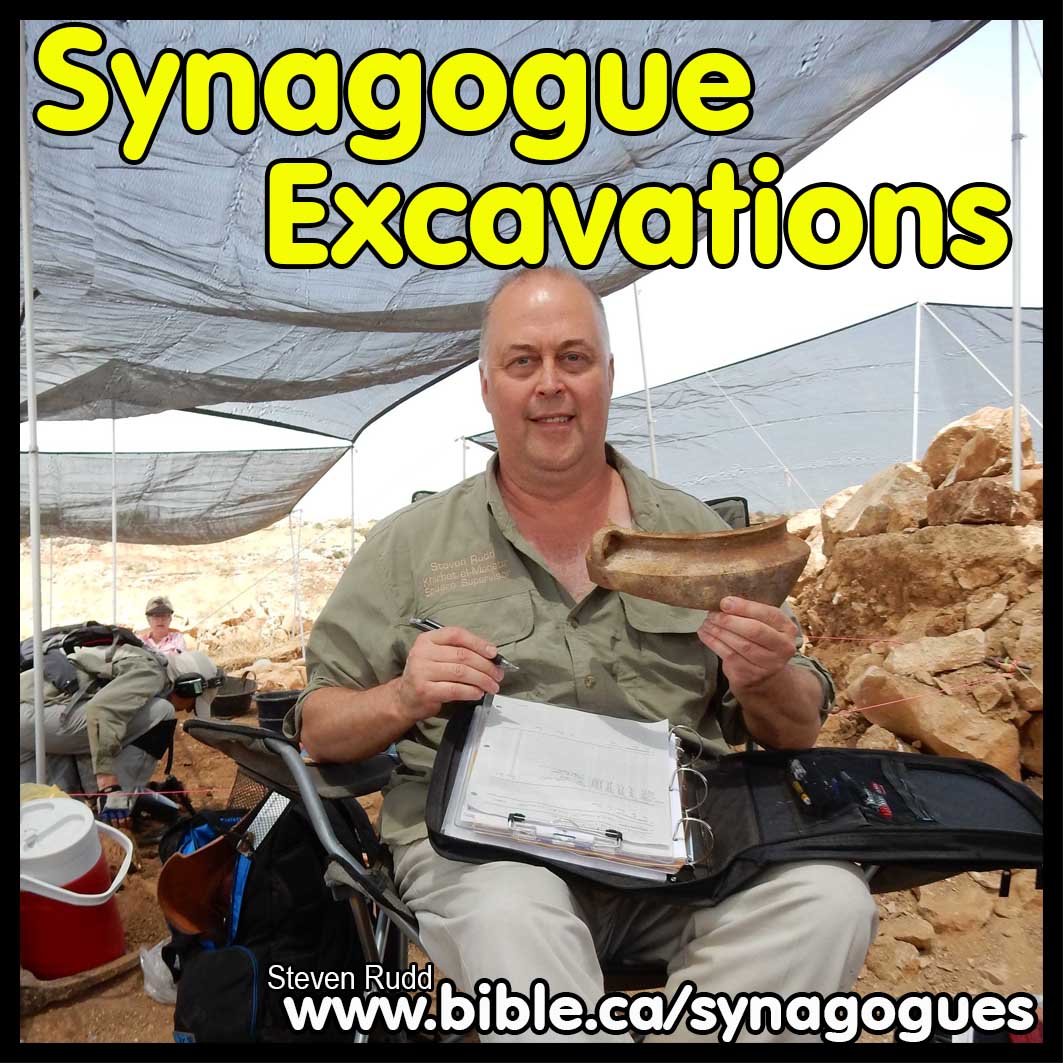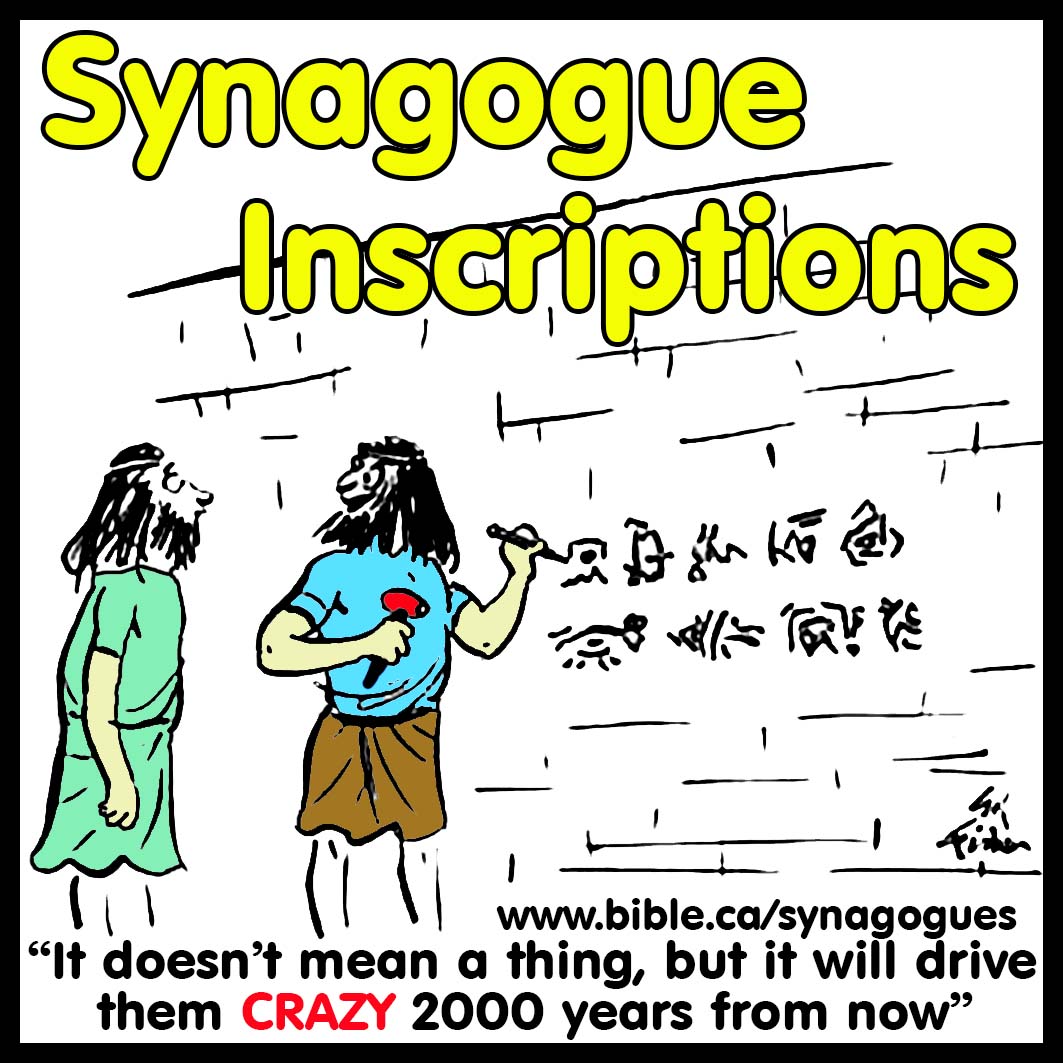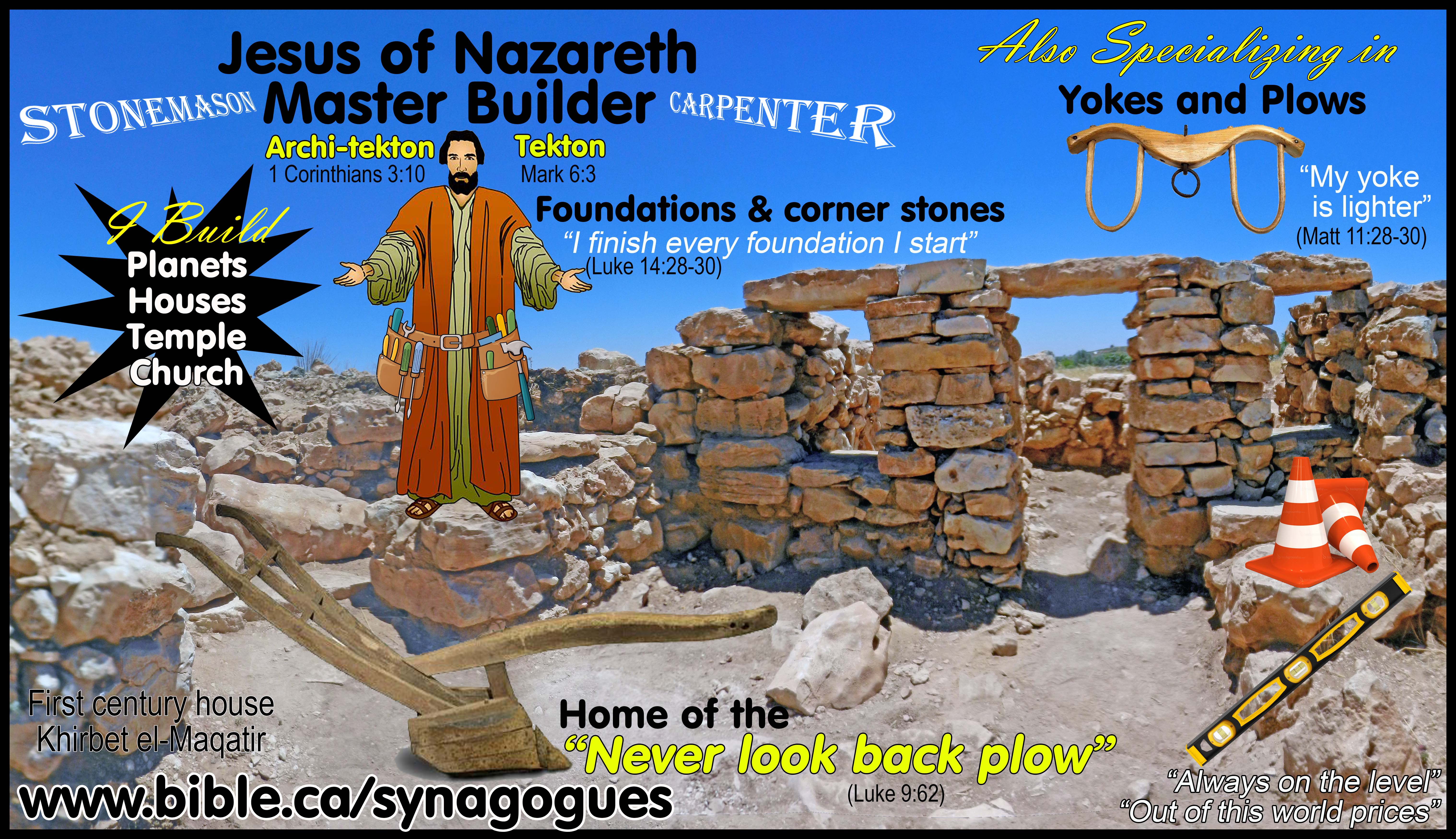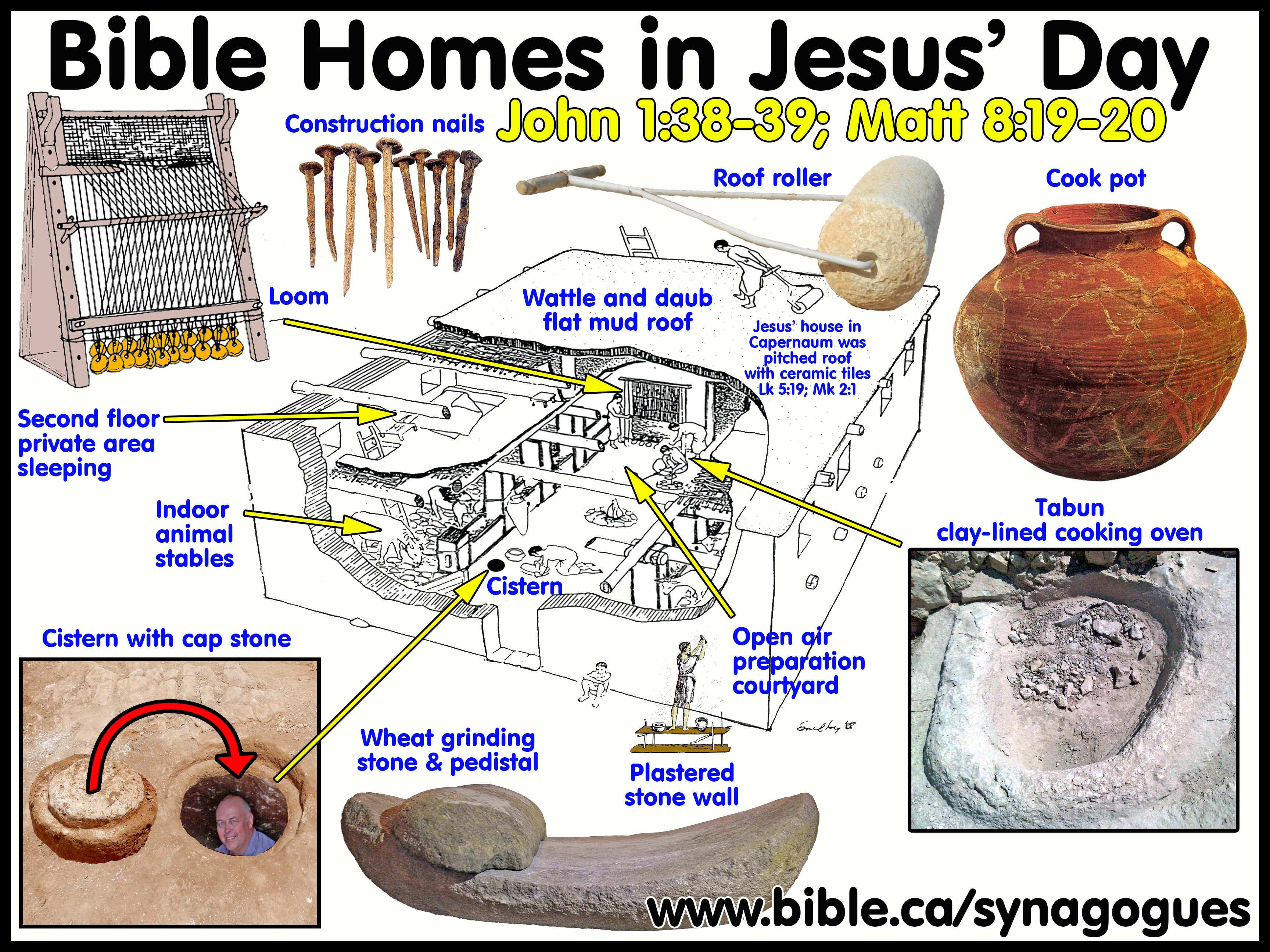Ancient Synagogue Inscription from Jerusalem 18 BC
Synagogue Inscriptions from the Oldest Synagogues in the world
|
Jerusalem 18 BC |
A. Synagogue Inscription:
1. Inscription text: “Theodotos, the son of Vettenos1, priest and archisynagogos2, son of an archisynagogos, grandson3 of an archisynagogos, built the synagogue4 (συναγωγή- Synagoges] for reading the Law [i.e., the Torah] and teaching the commandments, and the guest chamber5, the rooms5, the water installations5 as an inn5 for those in need from foreign lands [i.e., the Diaspora], which [i.e., the synagogue] his fathers founded together with the elders and Simonides.”]
2. Glyptic Artifact: Greek Synagogue inscription on limestone
3. Provenance: Ophel Cistern at City of David Excavations in 1913 AD
4. Current location: Rockefeller Museum.
5. Synagogue Occupation Date (SOD) = Excavation date + Inscriptional date + Literary date = 169 BC
a. SOD computation system details
b. Excavation date: none
c. Inscriptional date: 18 BC
d. Literary date: 169 BC
ii. Philo 38 AD
iii. New Testament 30 AD
iv. Josephus 169 BC
6. Contemporary Rulers: Herod the Great
7. References:
a. JIGRE #22; Corpus Inscriptionum Judaicarum II, Jean-Baptiste Frey, 2.1404, 1952 AD
8. Related Literary references:
a. "Then some of those who belonged to the synagogue [gr: synagoge]. of the Freedmen (as it was called), Cyrenians, Alexandrians, and others of those from Cilicia and Asia, stood up and argued with Stephen. But they could not withstand the wisdom and the Spirit with which he spoke." (Acts 6:9–10)
9.
Literary references to may synagogues in Jerusalem: see details
at Jerusalem Talmud
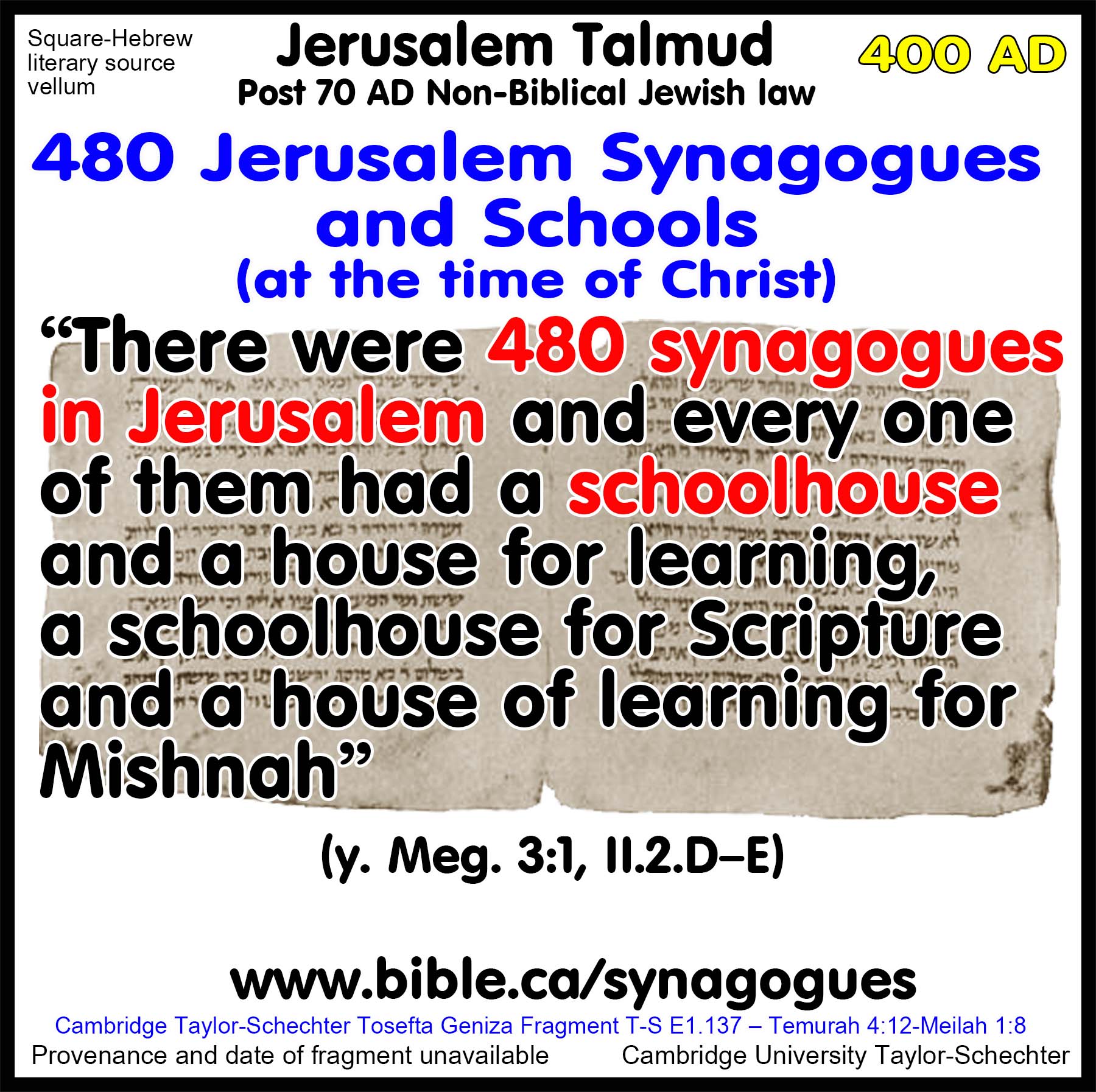
a. "They did not find me disputing with anyone in the temple or stirring up a crowd either in the synagogues [gr: synagogai – plural: many in Jerusalem] or throughout the city." (Acts 24:12)
b. “Indeed, I myself was convinced that I ought to do many things against the name of Jesus of Nazareth. And that is what I did in Jerusalem; with authority received from the chief priests, I not only locked up many of the saints in prison, but I also cast my vote against them when they were being condemned to death. By punishing them often in all the synagogues [gr: synagogai – plural: many in Jerusalem] I tried to force them to blaspheme; and since I was so furiously enraged at them, I pursued them even to foreign cities." (Acts 26:9-11)
c. “‘The house of the Lord’ refers to the Temple. ‘And the king’s house’ refers to the palace of Zedekiah. ‘And all the houses of Jerusalem’ refers to the 480 synagogues that were in Jerusalem. For R. Phineas in the name of R. Hoshaiah: “There were 480 synagogues in Jerusalem and every one of them had a schoolhouse and a house for learning, a schoolhouse for Scripture and a house of learning for Mishnah.” (Jerusalem Talmud, y. Meg. 3:1, II.2.D–E)
d. “Three judges of civil law were in Jerusalem, Admon, Hanan, and Nahum. Said R. Pappa, “Who is the Tannaite authority who repeats, ‘Nahum’? It is R. Nathan, in accord with that which has been taught on Tannaite authority: R. Nathan says, ‘Also Nahum the Mede was among those who make decrees in Jerusalem,’ but sages did not concur with him.” And were there no others? Didn’t R. Phineas say R. Oshayya said, “There were three hundred ninety-four courts in Jerusalem, corresponding to the number of synagogues and the number of schoolhouses and the number of schools for scribes”? There were many more, to be sure, but we make reference in particular to judges of civil law. Said R. Judah said R. Assi, “The civil judges who were in Jerusalem would collect their salary of ninety-nine maneh from Temple funds. If they didn’t find that suitable, they would add to the salary.” “If they didn’t find that suitable”? So are we dealing with money grubbers? Rather: “If they didn’t find that sufficient,” they would give them more, even though they didn’t want it.” (Babylonian Talmud, b. Ketub. 13:1, I.2.A–3.C)
10. Bible references for synagogue leaders: Jn 9:22-23; 12:42-43; 16:2-3; use “aposynagogus”
a. "His parents said this because they were afraid of the Jews; for the Jews had already agreed that anyone who confessed Jesus to be the Messiah would be put out of the synagogue [gr: aposynagogus]. Therefore his parents said, “He is of age; ask him.”" (John 9:22–23)
b. "Nevertheless many, even of the authorities, believed in him. But because of the Pharisees they did not confess it, for fear that they would be put out of the synagogue [gr: aposynagogus]; for they loved human glory more than the glory that comes from God." (John 12:42–43)
c. "They will put you out of the synagogues [gr: aposynagogus]. Indeed, an hour is coming when those who kill you will think that by doing so they are offering worship to God. And they will do this because they have not known the Father or me." (John 16:2–3)
d. “'the elders', appears on the Theodotus inscription from Jerusalem. The elder was probably a member of a specific community council (Roth-Gerson 1987:172-173, no. 19, see above). ” (Ancient Synagogues - Archaeology and Art: New Discoveries and Current Research, Rachel Hachlili, p20, 2013 AD)
e. “(Archisynagogos), one of the most important titles, and almost exclusively Jewish, meaning 'head of the synagogue', appears in several donors' inscriptions (Lifshitz 1967:nos. 79, 66, 74; Roth-Gerson 1987:171-72, nos. 19, 24, 27; Hachlili 1998:400). Scholars suggest that this title was synonymous with the Hebrew title nom unin (rosh ha-knesset). Rajak and Noy (1993:88-89) argue that he was a civic patron with a title and high standing in the community. The title is used in inscriptions found in the Land of Israel: in Jerusalem on the Theodotus inscription stone plaque (see above); 'the Berylos inscription' on a mosaic pavement at Caesarea (Avi-Yonah 1960:47); an inscription on a stone lintel found near Sepphoris that refers to two archisynagogoi, one of Sidon and one of Tyre (Huttmeister 1977:403-407; Roth-Gerson 1987:no. 24; Weiss 2005:3), and on two inscriptions on marble slabs which might have belonged to the synagogue at Beth She'arim (Roth-Gerson 1987:134, 137, 143, nos.,II, VI). The archisynagogos was very influential in the Jewish community. The title was sometimes inherited, being passed on from father to son, probably in important priestly families, and perhaps for life (see the Jerusalem Theodotos inscription, above and Chapter XI). The task of the archisynagogos was to arrange the worship in the synagogue, to supervise the study and reading of the Torah, to preach, and to perform other general tasks. He could also have other functions, such as priest, a title cited in the Jerusalem Theodotus inscription, while in the Caesarea inscription, Berilos is referred to as frontistes, 'an inspector' (Roth-Gerson 1987:174, no. 27). The archisynagogos could also be in charge of a specific community based on geographical origin (see the Sepphoris lintel inscription), a shared profession, or a specific neighborhood of a town. Some archisynagogoi donated entire synagogue buildings or parts of them, as well as architectural decorations etc. Inscriptions mentioning archisynagogoi on epitaphs are found at several sites in the Roman Empire, for example, at Aegina, Apamea, Ostia, and Hammam-Lif. Thirty-two inscriptions mentioning 40 archisynagogoi are dated to the first to sixth centuries CE. ” (Ancient Synagogues - Archaeology and Art: New Discoveries and Current Research, Rachel Hachlili, p19, 2013 AD)
B. Inscription footnotes:
1. Roman name: Jews enslaved in 63 BC by Pompey Tacitus, An. 2.85 were emancipated Philo Embas 155 possible connection with “Synagogue of Freemen” of Acts 6:9.
2. “archisynagogos” synagogue leader, used in Mk 5:22; Lk 13:14; Acts 13:5; 18:8, 17
a. See: Organization of Synagogues: Elders, officials, attendants, Independent, autonomous
3. The synagogue which cannot date later than 70 AD had existed for 3 generations. c 50 BC
4. Greek: “synagoges”, instead of “house of prayer” (proseuche)
5. Like Crocodilopolis 113 BC, water and housing provided for visiting preachers and the needy.
a. See Appendages: Hostels, Housing and Food Banks in Synagogues
b. The Land survey of Crocodilopolis 113 BC
d. Xenephyris 139 BC inscription
C. Synagogue of the Freedom connection:
1. “The Roman connection has been suggested by Clermont-Ganneau ("Decouverte," 196-97) on the basis of: (I) gens Vettia or Vectia being associated with that city, and (2) a person by the name of Vettienus mentioned by Cicero. This suggestion has been accepted by some (e.g., Schwabe, "Greek Inscriptions," 363-64)” (The Ancient Synagogue, Lee Levine, footnote 51, p57, 1999 AD)
2. Jews enslaved in 63 AD by Pompey:
a. “Another debate dealt with the proscription of the Egyptian and Jewish rites,96 and a senatorial edict directed that four thousand descendants of enfranchised slaves, tainted with that superstition and suitable in point of age, were to be shipped to Sardinia and there employed in suppressing brigandage: "if they succumbed to the pestilential climate, it was a cheap loss." The rest had orders to leave Italy, unless they had renounced their impious ceremonial by a given date.” (Tacitus, Annales 2.85)
b. Jews Freed: “How then did he look upon the great division of Rome which is on the other side of the river Tiber, which he was well aware was occupied and inhabited by the Jews? And they were mostly Roman citizens, having been emancipated; for, having been brought as captives into Italy, they were manumitted by those who had bought them for slaves, without ever having been compelled to alter any of their hereditary or national observances.” (Philo Embassy 155)
3. “The term "Freedmen" or "Libertines" in this passage has attracted much attention. Many have identified this synagogue with the Theodotos inscription (see below) on the basis of passages from Tacitus and Philo, which indicate that the Jews who had been brought to Rome in captivity were soon freed. Theodotos' family apparently hailed from Rome, as the Roman name Vettenos seems to imply; in all probability they were descendants of Jews taken captive by Pompey in 63 B.C.E. Alternatively, some scholars, following several ancient manuscripts and older commentaries of Acts, read "Libyans" instead of "Libertines," a name that would fit the North African setting of the following two geographical names on the list. Finally, in line with rabbinic evidence, Jeremias has suggested that the entire list in Acts reflects one community and should be identified with the "Synagogue of the Alexandrians" (or "Synagogue of the Tarsians" according to certain manuscripts).” (The Ancient Synagogue, Lee Levine, p56, 1999 AD)
D. Further documentation and comments:
1. The three generations of men listed on the inscription show that while the inscription dates to the first century AD, the grandfather would clearly date before the birth of Christ in 2 BC.
2. The synagogue was likely destroyed in 70 AD but the inscription may date to 30-40 AD which gives a founding date for the synagogue from 100 BC down to 10 BC.
3. Dating before Christ to the time of Herod the Great, the ten line Greek Theodotus Synagogue Inscription was found in Jerusalem and dates to before. What is amazing, is that this Greek inscription evidences that the "reading of the Law and for the study of the precept" was probably from the Greek Septuagint!
4. The inscription dates to the exact same time that Herod the Great completed the Jerusalem temple.
5. “An early Greek inscription from Jerusalem (the Ophel) uses the Greek word synagogę for “synagogue.” The pre-70 C.E. date of this inscription has recently been challenged, but further research tends to vindicate the early date. The text, carefully chiseled into a limestone block, was discovered in 1913 and is on display in the Rockefeller Museum in Jerusalem.” (The encyclopedia of Judaism, J. Neusner, Volume 4, Page 1920, 2000 AD)
6. “Kloppenborg (2000:276-77) refutes Kee's assumption and agrees with most other experts who view the Theodotus inscription as evidence of a pre-70 CE synagogue at Jerusalem, based on three important considerations: (1) The pre-70 CE term synagogue (in Greek) means only a 'gathering', `assembly' or `congregation', not a building. Another inscription from Bernice/Benghazi (Bernike in Cyrenaica, dating to 55/6 CE) mentions renovating a synagogue, in which case the reference must be to a building; (2) The paleography of the inscription is a lapidary script similar to and consistent with Herodian script, therefore antedating 70 CE; (3) The stratigraphy of the site in which the inscription was found is Herodian and rules out a date later than 70 CE. He concludes that the synagogue in Jerusalem was constructed in the late 1st c. BCE or early 1st c. CE. He further cites the writings of Josephus, as well as Philo's discussion of the Essenes (OmnProbLib81), as evidence that by the mid-1st .c. CE the term synagogue was used to refer to both the congregation and the building. ” (Ancient Synagogues - Archaeology and Art: New Discoveries and Current Research, Rachel Hachlili, p9, 2013 AD)
7. Well established sects of synagogues in Jerusalem: “The significance of the Acts [6:1-5] passage is twofold. The list of Diaspora Jewish communities in Jerusalem is impressive. In contrast to Acts 2:5-11, which attests to a large and multifarious gathering "from every nation" in the Diaspora on the festival of Shavuot," our passage speaks of the institutionalized presence of Diaspora Jews in the city. Who initiated the establishment of these synagogues? Were they the initiative of those who settled in Jerusalem, or were they sponsored (in whole or in part) by the various Diaspora communities both to serve their former members and to attend to the needs of those compatriots visiting the city on pilgrimage?" We simply have no way of knowing.” (The Ancient Synagogue, Lee Levine, p56, 1999 AD)
8. “French archaeologist Raimund Weill discovered this most famous of early synagogue inscriptions in 1913 during his excavations of the lower eastern slope of the Ophel, the ancient City of David, which rests below the Temple Mount in Jerusalem. Recovered in a cistern about 50 metres due west of remains often identified as the Tower of Siloam, the dedication provides a valuable snapshot of a synagogue that existed in Jerusalem during the Second Temple period. This inscription was the centre of some controversy during the 1990s when Howard Kee challenged the earlier consensus that had dated it to the first century C.F-1 himself assigning an origin of two to three centuries later. This suggestion led several researchers, especially Riesner and Kloppenborg Verbin, to carefully re-examine both the monument's palaeography and the archaeological context of its recovery. Their conclusions vindicated the earlier view and firmly reestablished a pre-70 dating. Of the several remarkable features of this inscription, one of the most striking is its mention of the patron, Theodotos, as both priest and ruler of the synagogue (archisynagogos). Moreover, he is described as being the son and grandson of similar office-holders for this congregation. This identification suggests not only the potential for hereditary leadership within the early synagogues, but also the possibility that priestly families commonly populated such dynasties (cf. Philo, Hypoth. 7.12-3, No. 162; CJZ 72, No. 133). The inscription also refers to "the elders" (hoi presbyteroi; cf. Luke 7:3-5, No. 6) as holding subsidiary leadership and patronal roles under Theodotos and his predecessors. Vettenus, the surname of Theodotos, undoubtedly derives from either the Vetteni or Vettieni families of Rome, who are attested from the first century B.C.E. This connection has led some commentators to infer that Theodotos was their freed slave and, further, that his synagogue should be identified with the so-called "Synagogue of the Freedmen" mentioned in Acts 6:9 (No. 18). Such conjectures, however, overlook the naming conventions of the period, which indicate that Theodotos was a freeborn man who was not a Roman citizen (a manumitted slave of a Roman family was by law a citizen). It is thus more likely that Theodotos' father was simply named after the Vett(i)eni out of gratitude for some unspecified kindness to his family. Nevertheless, the preceding observations suggest that Theodotos' ancestors once lived outside of Palestine and returned to their homeland around the turn of the era. This supposition is strengthened by the fact that the dedication was inscribed in Greek, not Aramaic, and many of the synagogue's ancillary functions are geared towards pilgrims from the Diaspora—although these latter could conceivably have applied to any visitor from beyond Jerusalem's immediate environs. If the founders were indeed repatriate Jews, they did not call their building a proseuche, the more common word for the synagogue in the Diaspora. Instead, they adopted the term synagogue, which appears to have held the widest currency inside Palestine during the Second Temple period (e.g., Mark 1:21, No. 4; Luke 7:5, No. 6). The dedication gives the primary purpose of the synagogue as being a place for the reading and study of Torah-the most widely attested function for synagogues during this period. The other attributes are dearly secondary and more focused on tending to the needs of pilgrims, either out of hospitality or as a means of revenue for the congregation. In particular, the ancillary rooms associated with these functions could have accommodated those seeking to celebrate the Jewish feasts inside Jerusalem, especially Passover in the "guest-chamber" (xenon eis kataluma; cf. Mark 14:14; Luke 22:11) and Sukkoth in the "upper rooms" (thimata), this last probably a reference to rooftop cubicles where tents could be erected (Neh 8:16, LXX). Similarly, the cryptic phrase chresteria ton hydaron—literally "oracles of water"- carries a cultic sense and thus likely refers to ritual baths that pilgrims could use for purification rites ( Josephus, C. Ap. 2.104; Acts 21:24-6). Weill himself originally connected these with several pools unearthed near the discovery site (Weill, pl. III, Pl-P6). These latter can now be more accurately identified as miqveh or ritual baths.” (The Ancient Synagogue from its Origins to 200 AD, Anders Runesson, p54, 2008 AD)
9. “Undoubtedly, the single most important piece of evidence relating to the pre-70 Judaean synagogues generally, and Jerusalem synagogues in particular, is the Theodotos inscription, found by Weill in 1913-14 during the City of David excavations. Discovered in a cistern along with other building fragments, the stone slab bearing this inscription in all probability came from a nearby structure, traces of which were claimed to have been found. The inscription, written in Greek and dating from the first century C.E., is ten lines long and reads as follows: “Theodotos, the son of Vettenos, priest and archisynagogos, son of an archisynagogos, grandson of an archisynagogos, built the synagogue (συναγωγή- Synagoges] for reading the Law [i.e., the Torah] and teaching the commandments, and the guest chamber, the rooms, the water installations as an inn for those in need from foreign lands [i.e., the Diaspora], which [i.e., the synagogue] his fathers founded together with the elders and Simonides.” As noted, the name Vettenos appears to place this inscription among Jews who came from Rome. Of singular importance in this inscription is the listing of three synagogue activities: reading the Torah, teaching the commandments, and providing rooms and water for itinerant pilgrims. Whether the hostel services were intended only for Jews from Rome in the context of a Landsmannschaft or whether they were available to others as well is unknown.” (The Ancient Synagogue, Lee Levine, p58, 1999 AD)
10. The archaeological remains of the building connected to the Theodotos inscription are too scanty for this edifice to be included in the present discussion, even if its location is almost certainly just south of the temple mount where the inscription was found. Similarly, we have not enough information on the Qatzion building from the second century, nor is it possible to discuss the 'prayer room' of Shuafat. Future excavations on these three sites are indeed welcome and may solve many problems pertaining to the development of early 'synagogues'.” (The origins of the Synagogue, Anders Runesson, footnote 395, p359, 2001 AD)
11. Translated Greek inscription reads: "Theodotos, son of [or: of the family of] Vettenos, a priest and head of the synagogue, son of the head of the synagogue, who was also the son of the head of the synagogue, [re]built the synagogue for the reading of the Law and for the study of the precepts, as well as the hospice and the chambers and the bathing-establishment, for lodging those who need them, from abroad; it (the synagogue) was founded by his ancestors and the elders and Simonides." (Theodotus Synagogue Inscription, 18 BC)
By Steve Rudd 2017: Contact the author for comments, input or corrections
|
Jesus your messiah is waiting for you to come home! |
|
|
Why not worship with a first century New Testament church near you, that has the same look and feel as the Jewish Synagogue in your own home town. As a Jew, you will find the transition as easy today as it was for the tens of thousands of your forefathers living in Jerusalem 2000 years ago when they believed in Jesus the Nazarene (the branch) as their messiah. It’s time to come home! |
|
By Steve Rudd: Contact the author for comments, input or corrections.
Go to: Main Ancient Synagogue Start Page
